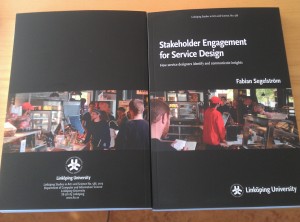First Swedish PhD thesis in service design

Stakeholder Engagement for Service Design is the title of the first Swedish PhD thesis in service design.
In the dissertation defended last week at Linköping University, Fabian Segelström wanted to find out how service designers go about to create an understanding of customers and others who are affected by a service, in order to develop services that better suit their needs.
Segelström explains in a press release at Linköping University that what often happens when a service designer enters a company is that the various departments of the company starts talking with each other and discover that they have much to gain by cooperating more.
Service designers offers a holistic approach that their clients, service provider, often lack. They see the entire process, from when the need arose service until it is delivered and credited made​​. It is about providing quality services and long-term satisfied customers, says Fabian.
He has been closely following service designers and their clients – different service companys – in participant observation in Sweden, Germany and Australia, for a total of nearly four months.
Full abstract:
Service design is a field emerging from the new-found interest in services as a design material by practitioners and academics of the human-centred design tradition. As such, the field can build on the knowledge from previous work in design as well as in service research. Introducing a new design material may however also introduce new challenges to practice. The research presented in this thesis investigates how the design research phase of the human-centred design process is affected by making services a design material.
How users, staff and other stakeholders are involved in service design projects was studied in four studies. Two studies focused on getting a holistic view of how service designers engage stakeholders in their design research. The methods used for these two studies were interviews in one case and participatory observation in the other. The two remaining studies focused on specific aspects of the stakeholder engagement process. One compared how designers and anthropologists approach ethnography, whereas the second investigated the communicative qualities of service design visualisations.
It is argued that service design is a stakeholder-centred design discipline. The tools used in service design are to a large extent borrowed from other qualitative research traditions, but design-specific tools do exist. By analysing and synthesising the information obtained, it is then transformed into insights. These insights are visualised to provide easily accessible representations of service situations.
The final section of the thesis identifies challenges ahead for service design practice, based on the findings of the thesis and based on existing theoretical frameworks for the discipline.




Had the honour of being Fabian’s “Faculty Opponent” at the examination and it’s well worth reading (and unlike many PhDs I’ve read – very readable too).